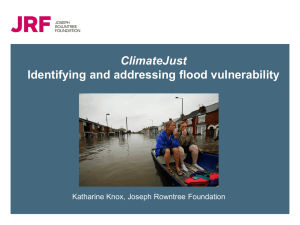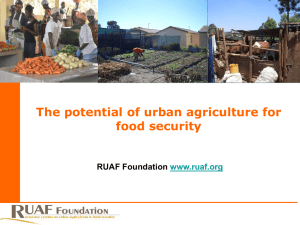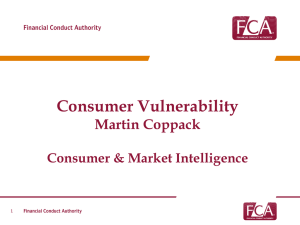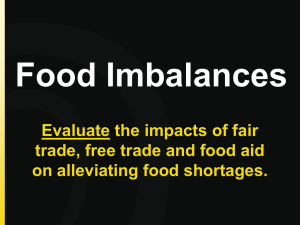- International Marketing Trends Conference
advertisement
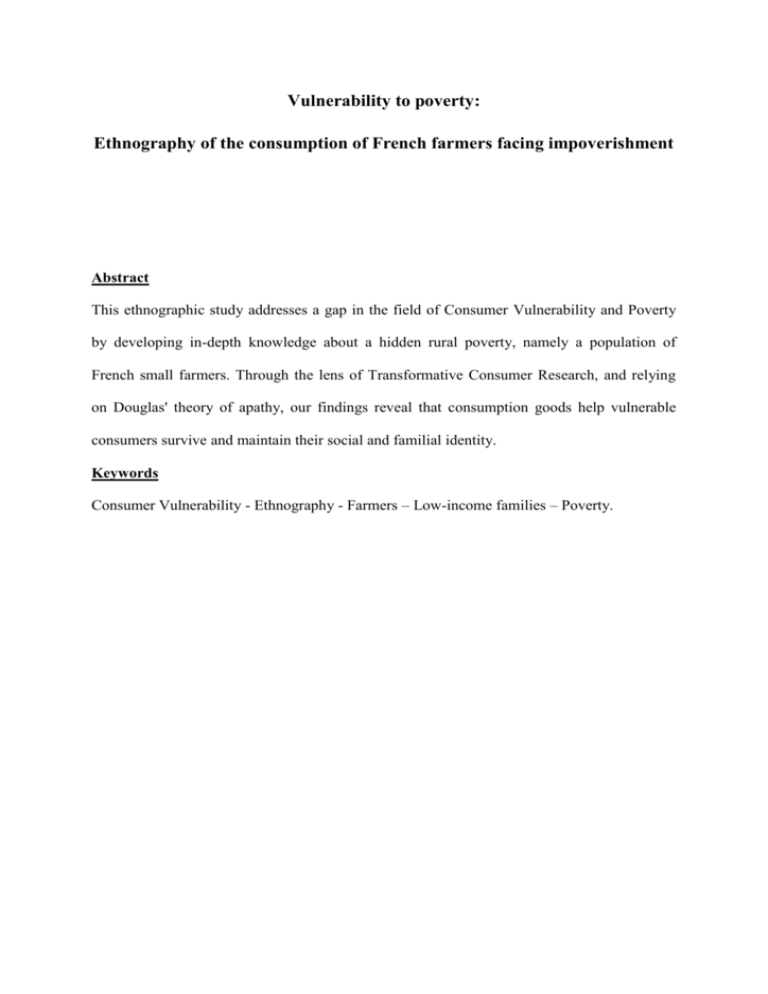
Vulnerability to poverty: Ethnography of the consumption of French farmers facing impoverishment Abstract This ethnographic study addresses a gap in the field of Consumer Vulnerability and Poverty by developing in-depth knowledge about a hidden rural poverty, namely a population of French small farmers. Through the lens of Transformative Consumer Research, and relying on Douglas' theory of apathy, our findings reveal that consumption goods help vulnerable consumers survive and maintain their social and familial identity. Keywords Consumer Vulnerability - Ethnography - Farmers – Low-income families – Poverty. Introduction When the Time magazine made its cover title about "France's Rural Revolution: Traditional French farms are dying"1, we could read beyond the lines and ask ourselves about the farmers whose farms are dying. Who are those farmers? How does this context impact their life, their family life, and their consumption? How are they facing this "revolution"? A closer look at this specific population of French smallholding farmers (a total of 328.000 families) gives striking figures for the year 2011 showing that more than 39.000 impoverished families of farmers are eligible for welfare assistance such as income support and the food bank. The phenomenon introduces an interesting paradox that has served as the starting point of our investigation, i.e., vulnerable farmers feed the nation, but depend on food banks for personal survival. The current research consists of an ethnography of consumption culture of vulnerable and impoverished consumers The originality of this study lies in the singularity of farmers as a community, and as a professional group that is facing a multi-level crisis (international, European, national, regional, departmental, professional, familial, individual). Conceptual framework and literature review We inform our study with three streams of literature. Firstly, Marketing and Poverty research (Townsend, 1962; Caplovitz, 1962; Andreasen, 1993; Alwitt, 1995; Adkins and Ozanne, 2005; Hill, 2008) address the behavior and culture of consumption of impoverished consumers, and offer concepts and theories to understand consumption patterns. Secondly, Sociology and Rural Sociology, see poverty as an issue related to the lack of social links and to the inability to express oneself through consumption goods and rites (Douglas, 2007), and offer concepts to understand coping behavior. Thirdly, Transformative Consumer Research 1 Time, August 2nd, 2010 (European edition) 2 (TCR) offers insights in how our research could help improve the lives (Mick, 2006) of farmers and their well-being (Ozanne & al., 2011). Several gaps appear from those works. Duflo and Banerjee (2009) highlight the need to study the behavior of one category of vulnerable consumers, facing impoverishment or poverty, in the rural context of a developed country. Mendras (1995) and Hervieu (2010) call for studies focusing on farming professionals to better understand how the various dimensions of their lives influence and depend on each other, i.e. their activities as producers and as consumers. Within the specific domain of TCR, we have identified calls for research to study unique and specific populations to develop the field of consumer vulnerability (Baker, Gentry and Rittenburg, 2005), and to study impoverished vulnerable consumers in rural areas of developed countries (Hill, 2008). More recently, Blocker & al. (2013) call for studies investigating how people are "affected when they are unable to participate in consumption norms that are prevalent in society", and to identify "the dimensions of poverty that affect self, family, social, community, and marketplace identities". This overview confirms the gap we want to explore through our main research question: how to characterize the notion of consumer vulnerability in this context of rural and farming space? Here are the two fundamental definitions we refer to, all along our ethnographic fieldwork. Firstly, let's start exploring the underlying basis of poverty from one short, but exhaustive, definition given by British anthropologist Mary Douglas (Douglas, 2007): "Poverty is the inability to maintain the exchanges that define you as a member of the society." We have here all items that guide our research investigation: relationships, exchanges, society, and the continuity between all that. Secondly, in their seminal article related to the "domain of consumer vulnerability", Baker and its coauthors clarify the concept of Consumer 3 Vulnerability and its boundaries to identify what it is and what it is not, in order to develop a consumer‐ driven definition of it (Baker, Gentry, Rittenburg et al., 2005). The contribution for macro‐ marketers is to shift from "considering a class of consumers as vulnerable" to, instead, qualify consumers as vulnerable only when they experience or express vulnerability. In other words, let's no longer say who is vulnerable... since everyone has the potential to be. From this overview, Baker et al. give a definition of Consumer Vulnerability, making it very clear that Consumer Vulnerability is not unmet needs, consumer protection, discrimination, nor prejudice stigmatization: "Consumer Vulnerability is a state of powerlessness that arises from an imbalance in marketplace interactions or from the consumption of marketing messages and products. It occurs when control is not in an individual's hands, creating a dependence on external factors (e.g., marketers) to create fairness in the marketplace. The actual vulnerability arises from the interaction of individual states, individual characteristics, and external conditions within a context where consumption goals may be hindered and the experience affects personal and social perceptions of self." Research design In line with Baker's & al model, we built our research questions around three axes. First, considering the creation of vulnerability through the interaction of "individual states, individual characteristics and external conditions", we explore how we can characterize and describe the notion of consumer vulnerability in the context of the rural and agricultural space. Second, taking into account both "consumer response" and "experience of vulnerability in a consumption context", we ask how we can characterize poor farmers' culture of consumption, knowing that one function of consumer goods is to make culture tangible. Last, concerning the "market and policy response", we explore the market for help and analyze the ties between vulnerable consumers and welfare public policies. 4 Our main leading thoughts, prior to field research, are anchored into the works of Mary Douglas, on the one hand, and of Jean-Pierre Boutinet, on the other hand. Douglas describes the cultural theory of apathy as a long-lasting state that emerges when the freedom to choose is suppressed, when socialization networks are destroyed, when despair is stronger than hope. Apathy makes any development project impossible: people are so desperate that they cannot see any exit anymore. Culture is a way of thinking which justifies a way of life. It must consequently be dynamic and able to change. Therefore, according to Douglas, we must take into account the mechanisms by which emerges a culture of apathy while researching on poverty alleviation. Different dangers threaten the viability of a culture: uncertainty about justice, loss of motivation, global disorientation, destruction of trust and confidence, loss of authority. Relying on Boutinet's works on the concept of project (Boutinet, 2012), we posit that a way out of this dead end of apathy occurs when vulnerable consumers build the project of creating new social links through consumption practices. What do we mean by project? It can be defined as a privileged coping strategy driven by the need for anticipation. It is also synonym of ability to create, to make change happen. Marginalized people are without, or aside, any sort of project because their constraints are such that they prevent them from necessarily standing back for anticipation. Method To follow the tradition inherent to the stream of research on poverty and vulnerability issues, we rely on ethnographic methods. We conducted 4 distinct studies in 2011 and 2012. Firstly, our preliminary study led us to conduct group-interviews (Arnould and Wallendorf, 1994) with 15 experts from social welfare and public policy, revealing the difficulties they face to reach small famers facing impoverishment. Secondly, we conducted follow-up interviews with twenty small farmers. Thirdly, we deepened our knowledge of three families, taking into account three generations (the farmer, the farmer's parents, and the farmer's children). We led 5 non-directive interviews, and especially used children drawing (Chan, 2006) to help them express their lived experience of poverty. Lastly, we proposed to one of our informants to do self-videography, in the way of a video diary like single-handed sailors sometimes do. All the interviews were transcribed, and field notes were taking during and after every interview. To analyze our written data, we led a content analysis (domain and theme analysis). Our field of research is in the French department of Vendée where we have established a partnership with an association called Solidarité Paysans2, which helps farmers facing difficulties. The criteria to recruit those informants was that they all received income support from French government3. Findings On the whole, what farmers first express is their life of constraint and their state of vulnerability, even when everything is, or was, fine. Their life is a life of constant constraint, not only consumption constraints but also all kinds of constraints. To cope with constraints and vulnerability, they find logical and easy solutions. For example, to get enough money to pay for a special event like the wedding of a child, estimated around 6.000€ by one of our informants, farmers say it is easier to sell a cow than to go to the bank and ask for a new credit. In terms of coping strategies, beyond the non-declared work, we find out that farmers count on their children to be a proper workforce on the farm... whatever the season, whatever the hour of the day or of the night. In terms of consumption, this means that what some farmers first buy for their kids is working clothes, hats, gloves, and rubber boots. Another surprising example of consumption is the budget dedicated to leisure. Many farmers are single or divorced, and this is sometimes part of the reasons why the difficulties happened. To fight against this celibacy, some farmers use nearly all the money they manage to save to look for a new wife: "I dedicate a specific amount of money, each month, to invite a girl from Eastern countries... I want 2 3 "Peasants Solidarity" RSA : Revenu de Solidarité Active 6 to get married; I need someone with me to work in the farm... I'm too fed up, too tired..." To characterize Consumer Vulnerability in the context of the rural and agricultural space, we propose a typology of experiences of vulnerability when consumption is concerned, which allows us to identify farmers' reactions and adaptation to vulnerability as consumers in their fight against isolation. For example, farmers who see themselves as "entrepreneurs" initiate networks of barter economy. Those who reorient continuously their production experience the same lack of stability in their daily consumption. Farmers who remain on the fringe of development inevitably adopt a way of life similar to voluntary simplicity. Over-indebted farmers tend to deny their state of impoverishment and refuse to ask for resource allowances or to go to the food bank. Typology Verbatim The “invulnerable” ones “I don’t want my kids to suffer from my financial situation. So I borrow money to my parents, to some friends. I buy video games & coke for my kids. I also spend a lot on a website to find a Russian woman who would marry me, I need someone to help me at the farm.” The entrepreneurs “I’ve organized some weekly meet-ups to exchange, for free, food and clothes; it works so well that it could be a successful business!” “I sell some soil from a field I no longer use, I get paid cash in hand, and I can still manage to hide my dramatic financial situation to my wife since I do bring back a little money…” The phers philoso- “We have decided to change the values we give to our children. Now, a school bag must last at least 4 years, we won’t change it every year. And, at the supermarket, I teach them to look at the price per kilo, not per product. We’ll never go back to our previous level of living, so let’s get used to it!” The pragmatists “We live again the same way I was taught to live by my parents who were born after WW2; in fact, we can be fine with very little, we have very few needs.” 7 Table 1. Typology of vulnerable consumers and their consumption processes Poor farmers' culture of consumption is strongly rooted in their everyday life. Families experience vulnerability as a specific period of time which beginning is remembered as a strong event. For instance, a farmer told us that: "Before the mad cow disease, our life was a life of constraints, for sure, and it was ok for us. Being a farmer means having a life of constraints. But today, we suffer from new constraints which we haven't chosen, and we drown. We don't know when this will end. Every day we wake up for work but we lose more money than what we earn. We have given up some habits. We go back to former practices; we live next to nothing, like our grandparents did." Then, any single tool or good represents the material culture of the family's memory: an old coffee mill, the reuse of old sheets to sew up curtains or dresses, the familial hair scissors to avoid the cost of a hairdresser; etc. Staying in touch with their familial roots helps those farmers keep faith in their future. Consumption goods play a major role in fighting isolation. As an embodied support for family memory, objects have recalling power. They stand for secure root in the past to face the uncertain future. Moreover, attachment to family objects prevents social isolation within and outside the family. They support the family identity as a continuation of the collective and familial history and traditions (“us”), a reviviscence linked to affective experience (“me”), and reflexivity projected into one’s future (“I”). Poor farmers' relationship with aid is rather ambivalent. In terms of Mutual Aid, we notice that the rural is a locus for social innovation and resilience where farmers build on social capital and values like solidarity and thriftiness: “Our parents, and a neighbor, wanted to give us some money when they found out that we couldn’t buy food for the kids. But we refused… It’s not in our culture to accept money. We want to work, and we want to earn our living from our work, not from charity nor from public subsidies.” 8 In terms of Public Aid, we mainly observe two attitudes. First, they all deny their state of poverty: "When the social worker told us that we were eligible for food bank, we said ‘No! We’re not poor!'” We also observe the non-recourse to Social Rights: “I’m not stupid, I have diplomas, but I no longer have the capacity to write a letter to the administration, it’s all Greek to me, and I’m terrified that I will do something wrong…” Children's awareness of their family's state of vulnerability came up thanks to the use of drawing (Chan, 2006) as a support for the interview. The initial instruction is as follows: "Please draw your parent's work on the farm." Then, the child explains his or her drawing. Here is below an example of a child's degree of awareness of the financial severe situation within the family, and the harshness of daily life. Discussion The hardness of the field is obvious. Beyond a strong preparation based on previous experiences, each first meeting with a famer and his or her family was a renewed challenge and a 9 confrontation to raw reality. For instance, how to react when a farmer answers that, for him, luxury would be to commit suicide? The initial question was in terms of consumption, precisely "What would luxury be for you?" The researcher's reflexivity is prevailing all along the fieldwork, from the first phone call, to arrange a meeting, to the different steps on the field, especially during the interview. Sensitive moments as above did happen in every single family we met. They always happen in an atmosphere of trust, it is never a provocation (as we can see sometimes in TV reports). Some farmers have also given their feedback after the interview, saying that they could feel they were respected and listened to as whole individuals (and not in just their professional part, or familial part, for example). Throughout our studies, we can assert that the transitory experience of vulnerability tends to see its end once the vulnerable ones manage to nourish a project, be it material, subjective or relational. We have a European economy, a global economy, and the Common Agricultural Policy which are based on development, and the question is: Is this system viable or is it going to break down because the continuation of production and consumption doesn't work anymore? What is the meaning of all that? There are people who are involved in intensive agriculture, and who are completely constrained in a system where choice is more and more constrained. Hence, the question can also be "How are we going to learn to be poor?" instead of just suffering poverty. Limitations and further research The major limitation is traditionally due to the ethnographic method. Follow-up interviews limited in time with a small number of informants, in one region of one country… Further research should focus on international comparisons within occidental countries to make possible a comparison between consumer vulnerability in developed and in developing countries. Ethnographic insights always bring detailed explanations to behaviors that are mostly estab10 lished with figures. Cross methods and interdisciplinary research is the ideal key to bring useful knowledge in the field of poverty alleviation. Managerial implications The findings of this ethnography inform Social Marketing and Social Business by elaborating a specific knowledge of a specific kind of hidden poverty. We have portrayed a typology of the consumption processes within a vulnerable population, and enhanced the knowledge of the role of consumption goods in their strategies of identity survival. We also help the Social Marketing actors better target this population of impoverished farmers when preventing bankruptcy, social isolation or suicide. We posit that a common language has to be elaborated between public policymakers and impoverished people to improve their bureaucratic relationships. We also show that innovative qualitative methods of research strongly help elicit informant's narratives. The major contribution of this research is to broaden the concept of impoverished consumer behavior. Indeed, the concept of impoverishment may have implications for consumer behavior in general, knowing that most consumers face at least some restriction on the availability of products or their ability to afford them during some or all phases of their lives (graduate students, temporarily unemployed people...). Any individual experiencing a phase of vulnerability and of transition may see his or her consumer life seriously thrown into disorder. 11 Bibliography Adkins, Natalie Ross and Julie L. Ozanne (2005), The Low Literate Consumer, Journal of Consumer Research, 32 (June), 93-105. Alwitt, Linda F. (1995), Marketing and the Poor, American Behavioral Scientist, 38, 4, 564677. Andreasen A.R. (1993), Revisiting the disadvantaged: old lessons and new problems, Journal of Public Policy and Marketing, 12, 2, 270‐ 75. Arnould E.J. and Wallendorf M. (1994), Market‐ oriented ethnography, Journal of Marketing Research, Vol. 31, 4, 484‐ 504. Baker S.M., Gentry J.W., and Rittenburg T.L. (2005), Building Understanding of the Domain of Consumer Vulnerability, Journal of Macromarketing, 25, 128‐ 139. Blocker C, Ruth J, Varman R, et al. (2013), Applying a Transformative Consumer Research Lens to Understanding and Alleviating Poverty, Journal of Research for Consumers, 19, 1-9. Boutinet J.-P. (2012), Anthropologie du projet, PUF. Caplovitz D. (1963), The poor pay more, MacMillan Company. Chan K. (2006), Exploring children’s perceptions of material possessions: a drawing study, Qualitative Market Research: An International Journal, 9, 4, pp. 352‐ 366. Crumley B., France's rural revolution, Time, august 2, 2010, pp. 14‐ 19. Douglas M. (2007), Poverty as a problem of freedom, Revue du MAUSS, 30, 438‐ 451. Duflo E., Banerjee A. (2009), The Experimental Approach in Development Economics, Annual Review of Economics, 1, 1, p. 151-178. Hervieu B., Viard J. (2011), L’Archipel paysan: la fin de la république agricole, Editions de l’Aube. Hill R.P. (2008), Disadvantaged consumers, Journal of Business Ethics, 80, 1, 77‐ 83. Mendras H. (1995), Peasants Societies, Gallimard. Mick, David Glen (2006), Meaning and Mattering through Transformative Consumer Research, Advances in Consumer Research, 33, 1-4. Ozanne, J., Pettigrew, S., Crockett, D., et al. (2011). The Practice of Transformative Consumer Research - Some Issues and Suggestions. Journal of Research for Consumers, 19, 1-7. Townsend P. (1962), The meaning of poverty, The British Journal of Sociology, 13, 3, 210‐ 227. 12

